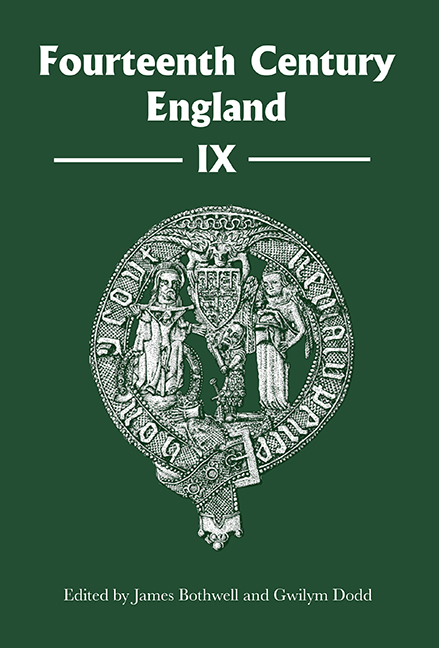Book contents
- Frontmatter
- Contents
- List of Illustrations
- Contributors
- Preface
- Abbreviations
- The Death of Edward II Revisited
- Living in the Shadows: John of Eltham, Earl of Cornwall (1316–36)
- Careers of the Lesser Parochial Clergy Before the Black Death
- Heritage and Symbolism: the Romans and Tanners in Fourteenth-Century York
- ‘Let Them Realize What God Can Do’: Chivalry in the St Albans Chronicle
- Historical Writing in the North-West Midlands and the Chester Annals of 1385–88
- High-Status Execution in Fourteenth-Century Ireland
- Traitor to the Chose Publique: Negotiating Constitutional Conflict Through the Law of Treason 1399–1402
- Notes and Documents – A Letter from Chatton: the Date and the Writer
- Fourteenth Century England Issn 1471–3020
High-Status Execution in Fourteenth-Century Ireland
Published online by Cambridge University Press: 07 May 2022
- Frontmatter
- Contents
- List of Illustrations
- Contributors
- Preface
- Abbreviations
- The Death of Edward II Revisited
- Living in the Shadows: John of Eltham, Earl of Cornwall (1316–36)
- Careers of the Lesser Parochial Clergy Before the Black Death
- Heritage and Symbolism: the Romans and Tanners in Fourteenth-Century York
- ‘Let Them Realize What God Can Do’: Chivalry in the St Albans Chronicle
- Historical Writing in the North-West Midlands and the Chester Annals of 1385–88
- High-Status Execution in Fourteenth-Century Ireland
- Traitor to the Chose Publique: Negotiating Constitutional Conflict Through the Law of Treason 1399–1402
- Notes and Documents – A Letter from Chatton: the Date and the Writer
- Fourteenth Century England Issn 1471–3020
Summary
Justice in the late medieval period was always swift, and often brutal. The court records for fourteenth-century Ireland provide us with a sense of how unmerciful the courts could be, particularly to those of low social status. In England, those who could not afford to pay fines were more likely to be executed than their wealthier contemporaries, and these trends are broadly reflected in Ireland. Social status was not the only deciding factor in terms of who faced execution, because those of Gaelic Irish ethnicity were more likely to be executed than their English counterparts. There was some truth in the saying ‘poor man be hanged by the neck, rich man by the purse’, but as this chapter will demonstrate, being of high social status, with good connections, did not always save someone from the gallows.
In England during the late thirteenth and early fourteenth centuries, there was a sharp increase in the number of high-status, politically motivated executions. This period marked a significant growth in political violence across the Plantagenet empire, which included the increasingly barbaric executions of high-status individuals. Initially, most of those executed were Welsh and Scottish nobles, such as Dafydd ap Gruffydd, prince of Wales, who in 1283 is the earliest example of a noble being hanged, drawn and quartered, and William Wallace who met the same fate in 1305. These harsh methods employed by the English administration may have been influenced by the kind of punishments meted out in the Gaelic periphery, where physical mutilation was relatively common.
In England, the vast majority of felons were hanged, but members of the knightly class were rarely executed for committing felonies. Hanging as a method of execution appears to have been reserved for those of low social status, while members of the gentry and nobility were despatched by other means, normally decapitation. When Roger Mortimer, first earl of March and lord of Trim, was hanged in 1330, this method may have been employed to symbolically strip him of his nobility. Most of those of high social status who were executed had committed treason or had antagonised someone more powerful.
- Type
- Chapter
- Information
- Fourteenth Century England IX , pp. 131 - 148Publisher: Boydell & BrewerPrint publication year: 2016



